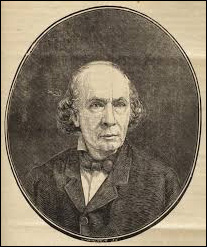
 The registry entry for Victor Bourgeau’s marriage to Edwidge Vaillant in 1834. Bourgeau has not signed.
The registry entry for Victor Bourgeau’s marriage to Edwidge Vaillant in 1834. Bourgeau has not signed.
VICTOR BOURGEAU – BIOGRAPHY
The churches of Montreal architect Victor Bourgeau (1809 – 1888) were appreciated during his lifetime, but their true quality was barely perceived. Admiration and understanding have only declined since then. My recent researches have revealed a degree of architectural excellence unmatched in Quebec, or even North America, in his time.
Victor Bourgeau was born the son of a wagon maker (charron) in Lavaltrie, some thirty miles downriver from Montreal. At an early age he was apprenticed to his uncle, a joiner and woodcarver, and so, like Palladio, spent his most formative years on construction sites.
 Bourgeau’s signature later in life. He has evidently become literate.
Signature de Bourgeau plus tard au cours de sa vie. De toute évidence, il a appris à écrire.
Bourgeau’s signature later in life. He has evidently become literate.
Signature de Bourgeau plus tard au cours de sa vie. De toute évidence, il a appris à écrire.The young Bourgeau had ambitions beyond the limits of his small town. Around 1830 he moved to Montreal, styling himself “master carpenter and master joiner”. But his formal education had been limited: it is notorious that when he married Edwidge Vaillant in 1833, he could not sign the register. Over the next fifteen years, he learned to read, and write, and draw, and acquired a deep knowledge of Architecture. This was an amazing achievement for a working man far from European centres of culture.
The 1830s were hard times in Quebec. The wheat crop, infected with the wheat midge failed repeatedly. Bread had been a staple in France, and was so here. Hunger was widespread. Opposition to British immigration was inflamed when newcomers brought a cholera epidemic in 1832. An international financial panic late in the decade caused a crisis in Montreal. Political conflict and agitation culminated in the Rebellion of 1837-38.
Trouble continued into the 1840s. Irish immigrants brought a typhus epidemic in 1847; rioters burned the Parliament Building in 1849. But conditions were improving. Agriculture was diversified, and improved transportation opened new markets. The economy expanded. Religious faith, badly shaken during the Rebellion, revived, at times to a state of evangelical fervour. The new bishop of Montreal, Ignace Bourget, even more ambitious than Bourgeau, began to realize his goals for his diocese. Late in the decade, there was an explosion of church building in the region.
 Victor Bourgeau looks away as Joseph Michaud presents plans for the new Cathedral to Bishop Bourget. From the statue of Bourget in front of Mary Queen of the World.
Victor Bourgeau détourne le regard pendant que Joseph Michaud présente ses plans de la nouvelle cathédrale à Monseigneur Bourget. Tiré de la statue de Bourget devant Marie-Reine-du-Monde.
Victor Bourgeau looks away as Joseph Michaud presents plans for the new Cathedral to Bishop Bourget. From the statue of Bourget in front of Mary Queen of the World.
Victor Bourgeau détourne le regard pendant que Joseph Michaud présente ses plans de la nouvelle cathédrale à Monseigneur Bourget. Tiré de la statue de Bourget devant Marie-Reine-du-Monde.
Victor Bourgeau was ready. He had worked on important buildings in Montreal: Notre-Dame, where he built a much-admired pulpit and Saint-Patrick, where he supervised interior work. Then, suddenly, around 1850, he became architect for Sainte-Rose-de-Lima in Laval, Saint-Grégoire-le-Grand near Saint-Jean-d’Iberville, La Visitation-de-l’Île-Dupas, and the remarkable Saint-Pierre-Apôtre in Montreal. He rebuilt the church at Saint-Benoît, burned by partisans during the Rebellion. And so began a long series of churches, each of them correct, appropriate, thoughtful and elegant.
Peter Lanken March 2018
In 1857 he was sent to Rome by the Bishop, with instructions to measure Saint-Peter’s and prepare drawings for a replica in Montreal. Not surprisingly for a country boy from Quebec, he was overwhelmed, and refused the commission. The Bishop persisted, and in 1871 sent Joseph Michaud, a cleric from Joliette, on the same mission. Michaud began work on the new Cathedral of Mary Queen of the World, but quickly ran into trouble. Bourgeau had to be called in to supervise construction.
Edwidge Vaillant passed away in 1877. Two children had died in infancy, and a third, Victor Pierre Henry, a promising lawyer, died in 1865 at age 31. Bourgeau remarried in 1878, to Delphine Viault. He passed away in 1888.